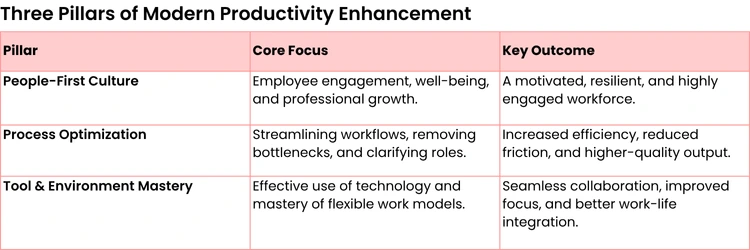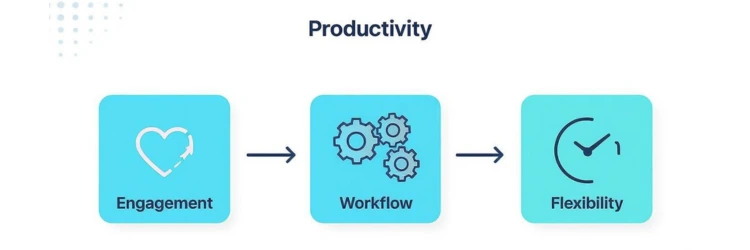How to Increase Employee Productivity That Actually Lasts

To really move the needle on employee productivity, we need to think beyond outdated management tactics. It's about focusing on three core pillars: nurturing genuine employee engagement, dialing in team workflows, and truly mastering flexible work practices. This isn't about pushing people harder; it's a more human-centric, holistic approach that gets to the root causes of performance slumps.
Jump To Section

Earn As You Learn
Earn 25% commission when your network purchase Uplyrn courses or subscribe to our annual membership. It’s the best thing ever. Next to learning,
of course.
The Real Picture of Workplace Productivity Today
Let's be honest—boosting team performance feels tougher than ever. We're surrounded by countless apps and tools promising peak efficiency, yet so many managers are seeing productivity flatline or even dip. What gives?
The problem usually isn't a lack of effort. It's a fundamental disconnect between old-school expectations and the new realities of work. Simply demanding more output is a recipe for burnout, not a breakthrough. The only sustainable path to a highly productive workforce is one built on a bedrock of trust, clarity, and well-being. This guide is designed to cut through the noise and give you, as a manager or L&D leader, a clear playbook with strategies that actually work.
Why Engagement is the Engine of Productivity
Productivity isn't just about how much work gets done; it's about the quality and impact of that work. This is precisely where employee engagement comes into play. When employees are disengaged, they often fall into "quiet quitting"—doing just enough to get by. They're not motivated to innovate, collaborate with energy, or go that extra mile for a customer.
The economic fallout is massive. Globally, a staggering 21% of employees report feeling engaged at work. This widespread apathy creates a huge drain on the economy, with some estimates putting the global productivity loss at $438 billion.
It's a simple truth: when people feel connected to their work and valued by their organization, their performance naturally skyrockets.
A team's productivity is a direct reflection of its engagement and well-being. When people feel supported, respected, and clear on their purpose, they are empowered to do their best work. This isn't just good for morale—it's essential for business success.
This brings us to a crucial starting point for any leader: understanding the drivers of defining job satisfaction and its impact on work performance. Satisfied, engaged people are the true foundation of any high-performing team.
To tackle this, we need a clear framework. The table below outlines the three strategic pillars we'll be diving into throughout this guide. Think of it as your roadmap to building a more productive, motivated, and resilient team.
By focusing on these three interconnected areas, you can create a positive feedback loop where engaged people, efficient processes, and the right tools all work together to drive sustainable productivity.

Finding the Real Reasons for Low Productivity
Before you can solve a productivity puzzle, you have to find all the pieces. Simply asking employees if they feel productive in a generic survey rarely uncovers the real issues. To truly understand what's draining your team's energy, you need to go deeper and observe the work as it happens.
Jumping to conclusions—like assuming the team is unmotivated or needs more training—often misses the mark. The root cause is frequently buried in the daily processes, tools, or communication habits that have become second nature. To find it, you have to become a detective within your own team's workflow.
Moving Beyond Guesswork
The first step is to get a firsthand look at the daily hurdles your team faces. This isn't about micromanaging; it's about gaining empathy and a clear-eyed view of their reality. Instead of relying on assumptions, you can use a few practical diagnostic methods.
Here are a few hands-on approaches to diagnose what's really happening:
- Work-Shadowing: Spend a few hours quietly observing a team member as they go through their day.
- For example, watch a sales rep build their pipeline. Note how many different systems they have to log into and how much time is spent on manual data entry versus actual client calls. This provides invaluable, unfiltered insight.
- Blocker Analysis Sessions: Host a dedicated meeting (not a complaint session) where the sole purpose is to identify obstacles. Ask a simple question: "What is one thing that regularly slows you down or makes your job harder than it needs to be?"
- Actionable Insight: Use sticky notes (real or virtual) and have everyone write down their top three blockers anonymously. Group similar issues together to instantly see recurring themes. Document everything without judgment.
- Workflow Data Analysis: Look at the data you already have. How long do tasks sit in a particular stage of your project management tool? What is the average response time for internal requests?
- For example, if you see that design mockups sit in "Pending Review" for an average of four days, you've just pinpointed a major bottleneck. Numbers often tell a story that people can't articulate.
Uncovering Hidden Bottlenecks with Real Examples
Let's look at how this plays out in the real world. A marketing team was consistently missing deadlines for campaign launches. Management’s initial thought? The team just needed better time management skills.
But after holding a blocker analysis session, the real culprit came to light: a convoluted, multi-layered approval process. A simple social media graphic required sign-off from four different people, each with their own feedback loop. What should have been a one-day task was turning into a week-long ordeal. The problem wasn't the team's effort; it was the broken system they were forced to work within.
Here’s another classic scenario. A software development team's output had slowed down. A lot. Through work-shadowing, their manager realized the developers were getting bombarded by constant pings from three different chat applications. These interruptions shattered their ability to do the "deep work" that complex coding demands. The solution wasn't a motivational speech; it was creating clear communication protocols and designated "no-interruption" blocks.
A critical part of this diagnostic process is creating an environment where employees feel safe to be honest about what isn't working. Without that trust, you'll only ever get surface-level answers.
This sense of trust is everything. Building a culture where people feel comfortable pointing out inefficiencies is directly linked to the prominence of psychological safety in the workplace. When your team knows their feedback is valued, not penalized, they become your greatest asset in identifying and fixing productivity drains.
- Actionable Insight: To get started this week, try a simple productivity audit with your team. Use a shared document or a tool like Miro and have everyone anonymously list the top three things that waste their time or energy each day. The patterns that emerge will give you a powerful, actionable starting point for making meaningful improvements.
This infographic shows just how interconnected things like engagement, workflow, and flexibility are when it comes to boosting productivity.
As you can see, a smooth workflow and a flexible environment are really built on a foundation of employee engagement. Get that right, and you're well on your way.

Boosting Productivity with People-First Strategies
Once you’ve dug into why performance is dipping, it’s time to shift your focus to the single most important part of your company: your people. Lasting productivity isn't something you can squeeze out of a new app or a perfectly organized spreadsheet. It's grown in a place where people feel valued, supported, and can actually see a future for themselves.
Adopting people-first strategies is the only sustainable way to build a team that isn’t just productive, but also resilient and genuinely motivated. This means going beyond surface-level perks and digging into what really moves the needle: motivation, well-being, and a sense of psychological safety. When you invest here, you kickstart a powerful cycle where supported employees do exceptional work, which in turn drives the business forward.
Build Clear Pathways for Growth
Let's be honest: employees who feel like they're in a dead-end job are never going to be your top performers. One of the quickest ways to kill engagement is to let your people feel stuck. The antidote is creating transparent, accessible pathways for them to upskill and advance their careers.
This isn’t about just throwing a generic course catalog at them. It’s about connecting learning directly to what’s next in their career.
- For example, a junior marketing associate should see a crystal-clear learning path—maybe with specific courses on digital analytics, SEO, and campaign management—that directly leads to a Senior Specialist role.
- Actionable Insight: Create simple "Career Maps" for key roles in your team. For each role, list the core competencies and skills required for the next level up. Then, map specific internal training, mentorship opportunities, or external courses to each competency. This turns training from a "nice-to-have" into a real tool for career mobility.
Make Mentorship Actually Work
A formal mentorship program can be a total game-changer for productivity, but only if you set it up to succeed. Just pairing a new hire with a senior employee and hoping for the best rarely works. A great program goes further by setting clear goals, offering conversation starters, and actually tracking progress.
One approach I’ve seen work wonders is a "strengths-based" coaching model. Instead of just giving general advice, mentors help their mentees pinpoint their unique talents and find ways to lean into them in their daily work.
- As a practical example, I saw a tech company do this by pairing junior devs with senior engineers who were known experts in niche areas, like security or front-end design.
The results were incredible. They saw a 20% increase in project completion rates and a huge jump in engagement scores among the junior staff who participated.
Mentorship isn't just about transferring knowledge; it's about building confidence and connection. A strong mentor can help an employee navigate challenges, see their own potential, and feel more deeply connected to the organization's mission, directly impacting their daily productivity.
Building that sense of connection is everything. For a deeper look at this, check out this guide on the top employee engagement strategies to implement.
Prioritize Well-Being and Stop Burnout in Its Tracks
You can't have a serious conversation about productivity without talking about well-being. Burnout is the ultimate productivity killer. It leads to exhaustion, cynicism, and a steep drop in effectiveness. A truly people-first culture works proactively to prevent it from ever taking hold.
This starts with promoting a genuine work-life balance. Encourage your team to completely disconnect after hours, respect their time off, and—most importantly—lead by example. A manager sending emails at 10 PM sends a clear signal that the workday never really ends, no matter what the official policy says.
To keep your team productive for the long haul, you have to implement real strategies for overcoming burnout. It doesn't have to be complicated. Simple practices can make all the difference:
- Protected Focus Time: Block out "no-meeting" times on the calendar so people can actually get deep work done without constant interruptions.
- Actionable Insight: Implement "Focus Fridays" where no internal meetings are scheduled after 12 PM, giving everyone a dedicated block of time to catch up and finish their week's work.
- Clear Boundaries: Create team agreements that spell out expectations for response times on emails and Slack messages, especially outside of core hours.
- For example, establish a norm that non-urgent messages sent after 6 PM will be addressed the next morning.
- Real Flexibility: Empower people to adjust their schedules to fit their lives. Research shows employees working from home are 52% less likely to take unscheduled time off and are 24% happier when they can work remotely just one day a month.
At the end of the day, a people-first approach is just smart business. It recognizes that employees who are healthy, engaged, and growing are the very people who will drive your organization forward.

Optimizing Workflows and Using Technology Wisely
Beyond individual motivation, the systems and tools your team uses every day are the guardrails of their productivity. You can have the most driven person in the world, but they'll still be held back by a clunky, inefficient process. The goal here is to design workflows that feel effortless and to use technology as an accelerator, not just another source of digital noise.
Improving your team’s workflow doesn’t mean you need some massive, top-down overhaul. It really just starts with asking a simple question: "What's the most direct path to getting this done well?" By mapping out your existing processes, you can start to spot all the unnecessary loops, redundant approvals, and manual data entry points that secretly drain hours from the week.
Ruthlessly Cutting Out Low-Value Work
One of the best ways to do this is with value stream mapping. It might sound a bit corporate and complex, but the idea is actually pretty simple. You visually map out every single step in a process—from the initial request all the way to the final delivery—and label each step as either "value-adding" or "non-value-adding" from the customer's point of view.
Think about a marketing team creating a new blog post.
- Value-Adding Steps: Researching keywords, writing the actual content, designing the graphics, and hitting "publish". These are the things the customer cares about.
- Non-Value-Adding Steps: Waiting for one of five different people to approve the draft, manually copying and pasting the text into three different systems, or searching for a lost password to an account.
Once you see it laid out like that, the path forward becomes incredibly clear.
- Actionable Insight: Your goal is to eliminate, automate, or simplify as many non-value-adding steps as possible. If approvals are a bottleneck, can you reduce the number of approvers to two? If data entry is a time-sink, can you use a tool like Zapier to connect the systems automatically? This focused effort ensures your team’s energy is spent on work that actually moves the needle. If you want to dive deeper, you can explore the fundamentals by learning about the steps in service process improvement.
Using Technology as a Productivity Partner
Technology, especially AI, is a huge opportunity to amplify your team's output. But let's be honest—it's a double-edged sword. Without a clear strategy, new tools can quickly become just another distraction, adding to the chaos instead of cutting through it. The key is to be incredibly intentional about what you automate.
AI is already a big part of the modern workplace. Its usage has shot up to 58% of employees, which is a 107% jump since 2022. But just because people are using it doesn't mean they're using it well. Poorly managed AI tools can actually lead to longer work hours and less focus.
The best way to start is by targeting low-risk, high-impact tasks that are repetitive and eat up a lot of time. Instead of thinking of AI as a replacement for human skill, frame it as a powerful assistant that can handle the grunt work. This frees up your team for the more strategic, creative thinking that only people can do.
Technology should serve your process, not the other way around. Before you roll out any new tool, ask one simple question: "Which specific bottleneck or manual task will this eliminate?" If you don't have a crystal-clear answer, you might just be adding complexity, not solving a real problem.
Here are a few practical examples of how teams can use AI and other tools to get more done:
- For Customer Service Teams: An AI-powered knowledge base can be a total game-changer. I worked with one team that implemented a tool that analyzed incoming support tickets and automatically suggested relevant help articles. This simple change cut their average response time by 40%, letting agents focus their energy on the really tricky customer issues that required a human touch.
- For Content and Marketing Teams: Generating a first draft of an article, writing a dozen variations of a social media post, or summarizing a lengthy research report are all perfect tasks for AI. This doesn't replace the writer; it gives them a running start, turning a blank page into a structured outline they can then shape with their own expertise and creativity.
- For All Teams: We all know meeting summaries are a universal time-sink. Using an AI tool to automatically transcribe, summarize, and pull out key action items can save everyone hours each week. It ensures everyone is on the same page without forcing someone to spend an hour after the call typing up notes.
By focusing on optimizing the how of the work and being strategic with technology, you build a system where productivity isn't an occasional burst of effort—it's just the natural outcome of a well-designed work environment.
Making Hybrid and Remote Work Actually Work
Flexible work isn't just a trend anymore; it's the new standard for many high-performing teams. But while everyone loves the idea of hybrid and remote work, making it genuinely productive is where the real work begins. The secret isn't trying to replicate the old office environment online. It's about building an entirely new operating system for your team—one grounded in trust, intentional communication, and real connection, no matter where people log in from.
This means consciously breaking old habits. Think about the constant "got a minute?" interruptions that plague a physical office—that kind of thing is toxic in a remote setup. Instead, you need to cultivate a culture that fiercely protects deep, uninterrupted focus time. When you get this right, you don't just maintain productivity; you often see a huge boost, not to mention better retention.
Master Asynchronous Communication
One of the biggest traps remote teams fall into is the pressure to be "online" all the time. This is a fast track to burnout and completely defeats the purpose of the flexibility that makes remote work so attractive in the first place. The solution? Get really good at asynchronous communication, which is just a fancy way of saying you communicate without expecting an immediate response.
It's about moving important conversations out of chaotic instant messaging threads and into more organized spaces.
- For example, instead of a frantic group chat about a project update, post a detailed summary in your project management tool.
- Actionable Insight: Start a message that requires a thoughtful response with "No rush on this..." or "Asynchronously when you have a moment..." to signal that an immediate reply isn't needed. This simple shift allows everyone to review and respond on their own schedule, respecting different time zones and focus blocks. If you're looking for more specific strategies, there's some great advice on how to increase remote workers' productivity that can help.
Run Truly Inclusive Meetings
It’s an all-too-common scenario: some people are in a conference room, and others are just faces on a screen. This instantly creates an "us vs. them" dynamic. To make hybrid meetings actually work, you have to level the playing field by treating every single meeting as a remote-first event.
A few simple rules can make all the difference:
- Everyone joins from their own device. Even if two colleagues are sitting side-by-side in the office, they should each join the call from their own laptops. This equalizes the experience for everyone.
- Use the "raise hand" feature. This stops the loudest voices in the physical room from dominating the conversation and gives remote folks a clear path to jump in.
- Send agendas and materials well in advance. This gives everyone, regardless of their location, the time to prepare their thoughts and contribute meaningfully from the get-go.
- Actionable Insight: Appoint a rotating "remote advocate" for each hybrid meeting. This person's job is to watch for remote participants who are trying to speak and ensure their voices are heard. Adopting these practices ensures that great ideas can come from anywhere, not just from the people physically in the room.
Build a Team Charter
To head off misunderstandings before they start, work together to create a "Team Charter". This is a straightforward document, co-created by the entire team, that spells out your communication norms and expectations. Think of it as a living agreement that answers the critical questions before they turn into problems.
A Team Charter isn't just a rulebook; it's a mutual agreement that turns ambiguity into clarity. By defining how you'll work together, you free up your team's mental energy to focus on what you're working on.
Your charter should clearly define things like:
- Core Collaboration Hours: What's the specific window of time when everyone agrees to be available for quick chats or brainstorming sessions? Example: "We are all available for synchronous meetings between 10 AM and 2 PM EST."
- Primary Communication Channels: Which tool do you use for what? For example, Slack is for quick questions, email is for external comms, and Asana is for project updates.
- Meeting Etiquette: Lay down some simple ground rules, like "cameras on" or "agendas are required for all meetings".
This simple document removes guesswork and empowers everyone to work with confidence. The data backs this up: studies on hybrid models show that employees working from home a few days a week are just as productive as their in-office peers but have 33% lower turnover rates. That's a powerful reason to get it right.

Measuring What Matters and Driving Improvement
To really see these strategies come to life, you have to commit to continuous improvement. And that starts with throwing out outdated metrics like hours logged.
Let's be honest: true productivity isn't about looking busy; it’s about creating real value. This means a shift toward outcome-based Key Performance Indicators that actually tie back to the business's bottom line.
Think about it this way: for a support team, what matters more? The sheer number of tickets they close, or their customer satisfaction scores (CSAT)? For a product team, it's not about how many lines of code they write, but about the feature adoption rates that show people are actually using—and loving—what they built.
- Practical Example: A sales team could shift its primary KPI from "number of calls made" to "pipeline value generated". This incentivizes higher-quality interactions over sheer volume, directly aligning their daily work with the company's revenue goals. These are the kinds of metrics that change the conversation from "How much did you do?" to "What impact did we have?"
Creating Effective Feedback Loops
Of course, numbers on a dashboard are only half the story. The real magic happens when you build strong, consistent feedback loops around them.
This isn’t about using data to point fingers. It's about creating regular, collaborative moments where the team can get together, look at the results, and talk openly.
- Actionable Insight: Implement a brief, 15-minute "metrics huddle" at the start of each week. Review one or two key KPIs, celebrate any wins, and quickly brainstorm one small experiment to try that week to improve a lagging number. This makes data a collaborative tool for growth, not a source of anxiety. These conversations are your chance to celebrate what’s working, dig into what isn’t, and figure out how to pivot. When a team sees how their day-to-day efforts directly move the needle on key metrics, it builds a powerful sense of ownership and keeps everyone pulling in the same direction.
We often focus so much on output, we forget to protect the input—our team's focus. Research has found that typical office interruptions can pop up as often as every three minutes. What’s worse, it can take over 23 minutes to get back into a deep state of concentration after each one. Shielding your team from distractions is just as critical as tracking their results.
At the end of the day, boosting productivity isn't a one-and-done project you can just check off your list. It's a living, breathing cycle of measuring, getting feedback, and refining your approach.
By focusing on the right outcomes and fostering that open dialogue, you're not just managing tasks—you're building a system that fuels sustainable growth and keeps your team engaged, motivated, and performing at their absolute best.
Got Questions? I've Got Answers
Putting new productivity strategies into motion can feel like opening a Pandora's box of new questions. Let's tackle some of the most common hurdles managers run into when they're trying to boost team productivity and keep the momentum going.
How Do I Handle Team Members Who Are Resistant to Change?
The classic challenge. Resistance is a totally normal human reaction, especially if your team has been burned by failed initiatives in the past. The secret is to lead with empathy and make people part of the process.
Instead of just announcing a new mandate from on high, pull that resistant team member into the discovery phase. Sit down with them and ask, "What's the most frustrating part of our current workflow for you?" Get their unfiltered take.
- Actionable Insight: Frame any change as a low-stakes experiment. You could say something like, "Look, let's just try this new project management setup for two weeks. No long-term commitment. After that, we'll all get together and talk honestly about what worked and what didn't." This approach turns them from an obstacle into a partner. It gives them a voice and a sense of control over the outcome.
What’s the Best Way to Measure Productivity for Creative Roles?
This is a big one. You can't measure the output of a designer, writer, or brand strategist the same way you'd count widgets on an assembly line. Trying to track hours is a fool's errand. You have to shift your focus from output to outcomes.
Don't measure the time it takes to have a great idea. Instead, measure the impact that idea has on the business. For creative roles, value is a far better metric than volume.
- Practical Examples: Instead of obsessing over the number of articles written, start tracking metrics that actually tell you about quality and impact:
- Engagement Rate: Are people actually reading, commenting on, and sharing the content
- Lead Generation: Did that new landing page design actually drive more sign-ups?
- Client Feedback: What are the customer satisfaction scores saying about the creative work being delivered?
This simple shift changes the entire conversation from "Are you busy?" to "Are you being effective?"
How Do I Choose Tools Without Overcomplicating Things?
It's easy to get lost in the sea of productivity apps. Adding too many just creates "tool fatigue" where your team spends more time managing the tools than doing the actual work.
Before you even think about adopting new software, get crystal clear on the exact problem you're trying to solve. Is it communication breakdowns? Missed deadlines? Too much time wasted pulling manual reports?
- Actionable Insight: Pick one tool that addresses your single biggest pain point. For instance, if no one ever knows who's doing what, a simple, visual tool like Trello or Asana can can work wonders. Get it implemented, make sure everyone knows how to use it, and only then should you even consider adding another piece of software to solve a different problem.
Ready to build a more skilled and motivated team? Uplyrn offers an entire ecosystem of courses and expert-led training designed to close skills gaps and drive performance. Explore our learning solutions and see how we can help your team grow.


Leave your thoughts here...
All Comments
Reply